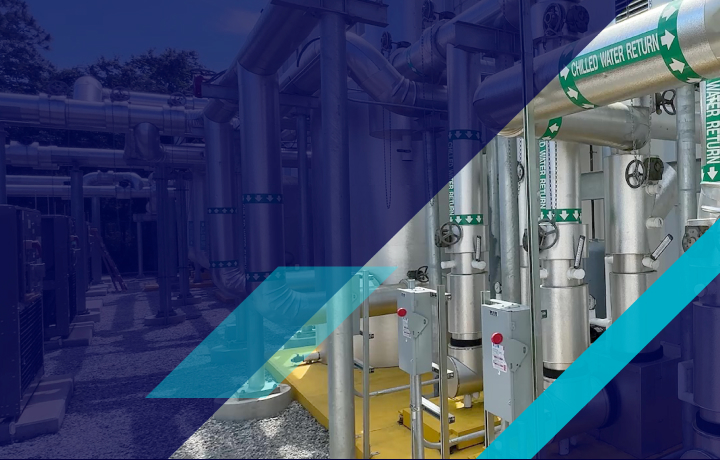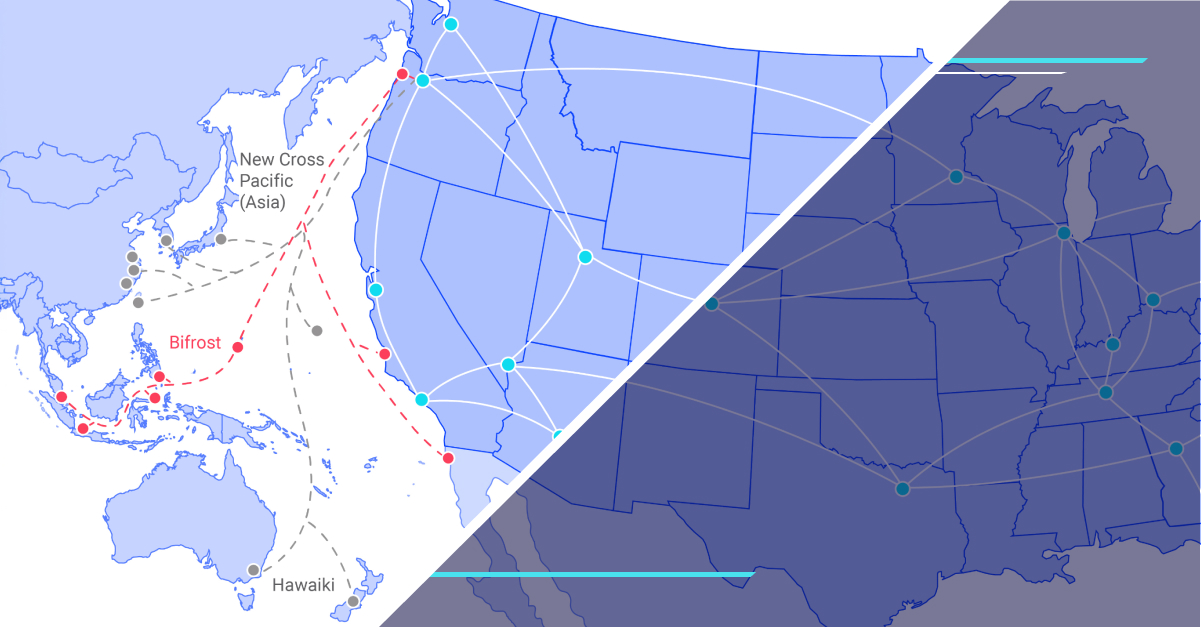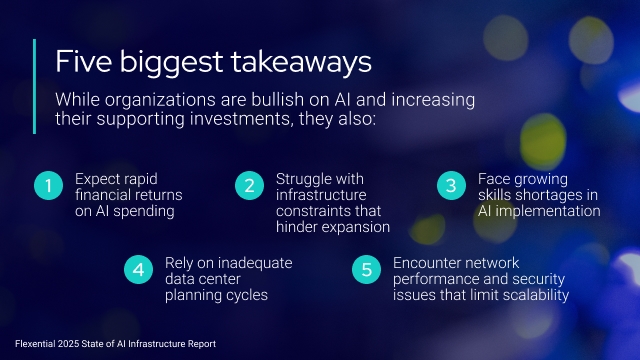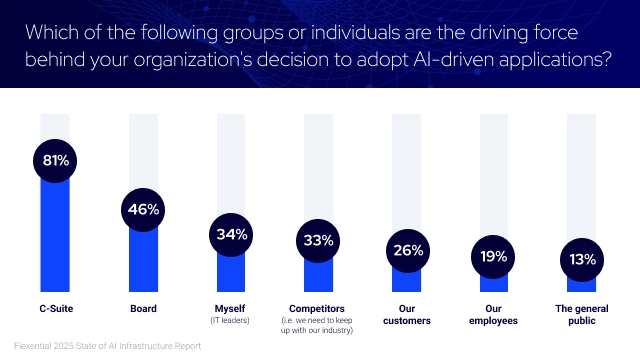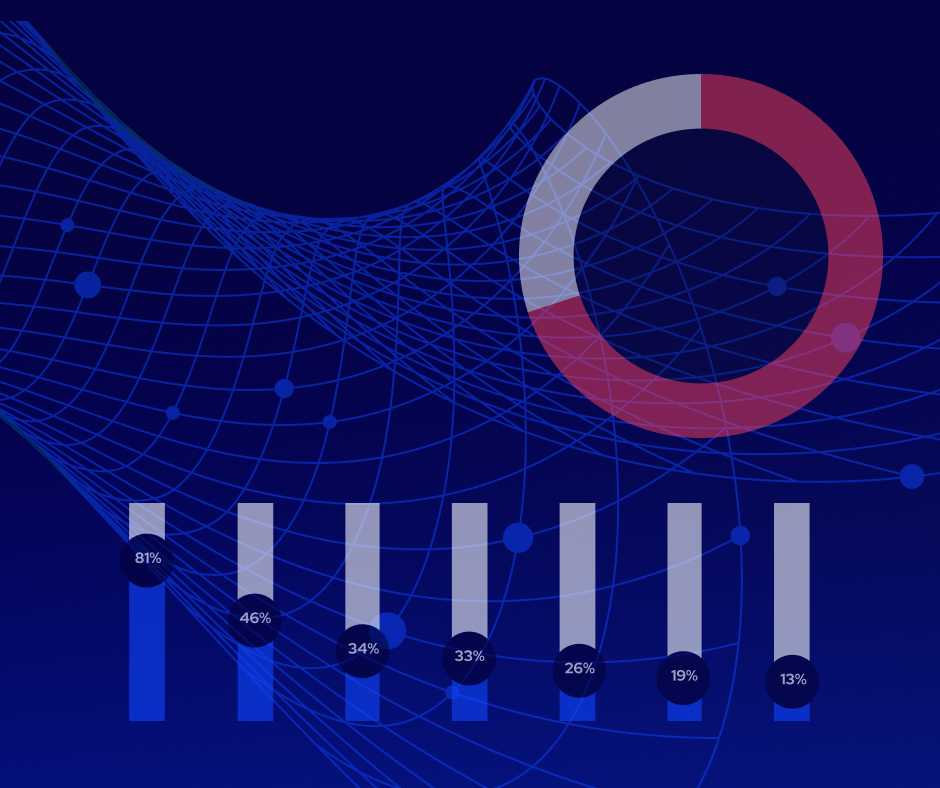AI fuels success—are your systems ready to keep up?
AI is now core to business strategy—not just an experiment. In our second annual survey of 350+ IT leaders, 90% are deploying generative AI, with strong optimism, but also rising pressure. C-suite executives have taken command of AI initiatives, according to 81% of respondents—a dramatic rise from the 53% who identified the C-suite as the main driver in last year’s State of AI Infrastructure Report. Additionally, 51% expect ROI within the next year. Most are planning infrastructure years ahead, but meeting AI’s growing demands requires even greater readiness.
AI optimism grows—but critical challenges remain:
- Expect rapid financial returns on AI spending
- Struggle with infrastructure constraints that hinder expansion
- Face growing shortages in AI-related skills and expertise
- Operate with outdated data center planning cycles
- Experience network performance and security issues that limit scalability
Key findings
- Confidence in their organization’s ability to execute AI roadmaps rose from 53% to 71% year over year.
- 81% say the C-suite is the driving force behind AI decisions—up 28 points from a year ago
- 70% are devoting at least 10% of total IT budgets to AI initiatives, including software, hardware, and networking.
- 44% say IT infrastructure constraints are the top barrier to expanding AI initiatives.
- 62% are planning IT infrastructure and data center needs 1-3 years ahead due to rising demand.
- 33% say AI governance lacks security protocols, and nearly half (48%) report gaps in bias detection policies.
- 86% are worried about acquiring or developing the specialized talent needed to meet AI goals.
- 61% report skills or staffing gaps in managing specialized computing infrastructure—up from 53% a year ago.
The AI roadmap
C-suite leadership drives investment as AI becomes a core business strategy
AI has shifted from exploration to enterprise strategy—led by the C-suite. With 81% of executives driving adoption, organizations are rapidly increasing investment. Over half expect financial returns within a year, measuring success through revenue, efficiency, and cost savings as AI becomes integral to long-term growth strategies.
Infrastructure demands, competitive pressure
Infrastructure limitations remain the top barrier to scaling AI, driving investments in high-density data centers and hybrid cloud. As tech giants raise the bar and market expectations grow, companies are accelerating adoption to stay competitive, leveraging AI to deliver measurable business outcomes across industries.
Leadership influence
Executives grow more confident in AI roadmaps as investments pay off
Executive confidence in AI execution has jumped from 53% to 71% in a year, driven by $246 billion in infrastructure investment and clear business results. Adoption of generative AI and weekly workforce usage have surged, signaling a move from pilot to enterprise scale as organizations build the foundation for rapid deployment.
{{statBigOne}}
The urgency to deploy AI effectively is evident in how companies shifting focus—from exploration to performance-driven execution through revenue, impact, and speed.
Risk of falling behind drives urgency
With market share, product speed, and revenue on the line, companies are prioritizing fast, secure AI adoption. Mature governance frameworks—spanning security, privacy, and bias mitigation—are enabling responsible scale. As expectations grow, firms must balance speed with compliance to sustain competitive momentum.
Get the AI Governance Playbook
The AI skills gap
Workforce shortages threaten AI growth and business innovation
Only 14% of leaders say they have the right talent to meet their AI goals. Skills gaps are worsening: 61% cite shortages in managing specialized infrastructure—up from 53%—and 53% now face deficits in data science roles. Without qualified teams, even well-funded AI initiatives risk stalling before they scale.
{{statOne}}
{{statTwo}}
As the demand for AI talent continues to grow, companies are pulling out all the stops to win over limited candidates, amidst a competitive hiring environment.
Training becomes a strategic imperative
To bridge the talent gap, 63% of organizations now deploy AI tools with built-in training, and 62% run structured in-house programs. Yet disparities remain—only 22% of baby boomers receive training, and most AI-skilled workers are men. Sustained workforce investment and inclusive upskilling are essential to ensure AI's long-term impact.
Capacity challenges
AI expansion, limited capacity force a reevaluation in data center infrastructure planning
The data center market is under unprecedented strain, with demand outpacing supply and power constraints disrupting traditional planning. While 94% of organizations express confidence in their infrastructure roadmaps, only 17% are planning 3–5 years ahead, placing the majority at risk of falling behind in securing capacity for AI-driven workloads.
Scarcity is driving up costs
Despite a 34% increase in supply and over 6,350 MW under construction, vacancy rates in key markets have plunged to a record-low 1.9%. With more than 70% of new builds pre-leased, access to power and space is constrained and increasingly expensive. Delays tied to skilled labor, supply chains, and utility access are pushing procurement timelines beyond 24 months, especially for organizations seeking 5 MW+ capacity.
{{statBigTwo}}
Find the Ideal Colocation Provider
Networking and security concerns
AI workloads require stronger networks and a smarter security approach
As AI reshapes enterprise workloads, organizations are embracing a hybrid mix of cloud and colocation to optimize performance, cost, and control. Today, 60% use private cloud, 48% operate in hybrid environments, and 47% leverage public cloud for AI data storage. The public cloud remains dominant for AI training data (68%), while GPU-as-a-service usage has climbed to 40%, reflecting the shift toward scalable, on-demand compute.
Network strain becomes the new bottleneck
Bandwidth shortages and latency have become critical constraints. 59% of organizations now report bandwidth issues, up from 43% last year, while latency challenges surged from 32% to 53%.
{{statBigThree}}
Although space and power constraints have eased slightly, legacy networks are ill-equipped to handle the high-speed, high-volume demands of AI at scale.
AI growth is outpacing cybersecurity readiness
As organizations scale AI, security vulnerabilities are intensifying. 55% say AI has increased exposure to cyber threats due to the volume and sensitivity of data, up from 39% last year. Over half (51%) acknowledge that AI expands their attack surface, while 46% admit their cybersecurity teams lack full AI security expertise.
{{statThree}}
{{statFour}}
Without updated frameworks tailored to AI risks, businesses face growing gaps in protection and compliance.
Sustainability pressure
Businesses face growing pressure to adopt sustainable infrastructure
Despite reduced regulatory pressure, sustainability remains a strategic imperative for enterprises. A significant 79% of organizations report increased pressure to enhance infrastructure sustainability compared to a year ago. Investor expectations and consumer preferences are driving this commitment, with 51% of companies willing to pay 11-20% more for renewable energy or carbon offsets.
{{statBigFour}}
This signals that environmental impact is now a core consideration in infrastructure decisions, not just a compliance box to check.
AI workloads drive surging energy and cooling demands
AI workloads are driving up power and water usage. U.S. data centers used 4.4% of electricity in 2023, with projections as high as 12% by 2028. Rack power densities have doubled to 17 kW, and cooling demands could hit 275B liters annually, pressuring companies to invest in efficient energy and cooling solutions.
Conclusion
It's already time for a fresh approach to AI infrastructure
AI is transforming how organizations operate. To keep pace, IT leaders must adopt scalable compute, software-driven interconnection, advanced cooling, and secure data management—while planning capacity ahead of demand. Working with an experienced data center provider gives you the reliable connectivity, bandwidth, and performance needed to fuel AI growth. Whether you’re driving innovation or staying ahead, long-term success depends on the infrastructure decisions you make today.
Click below to download this resource!

